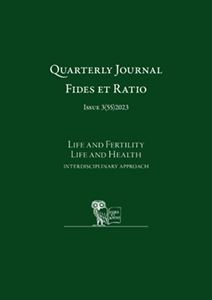Abstract
The process of labour is determined by various elements, and only some of them might be controlled by woman or medical professional. The conditions for efficient movement of the fetal head in birth canal, including the anatomy of the pelvis and soft tissues, uterine activity, fetal position and women's approach to the same are essential. This article describes techniques and methods which can be facilitated to gain the improvement and therefore advance the fetus through the birth canal in case of suboptimal condition of childbirth.
References
Ahmad, A. et al. (2014). Association between fetal position at onset of labor and mode of delivery: a prospective cohort study. Ultrasound in Obstetrics & Gynecology, 43(2), 176–182. https://doi.org/10.1002/uog.13189
Barrowclough, J.A. et al. (2022). Maternal postures for fetal malposition in labour for improving the health of mothers and their infants. The Cochrane Database of Systematic Reviews, 8(8),CD014615. https://doi.org/10.1002/14651858.CD014615
Barth Jr, W.H. (2015). Persistent occiput posterior. Obstetrics & Gynecology, 125(3), 695–709.
Bertholdt, C. et al. (2022). Manual rotation of occiput posterior or transverse positions: a systematic review and meta-analysis of randomized controlled trials. American Journal of Obstetrics and Gynecology, 226(6), 781–793. https://doi.org/10.1016/j.ajog.2021.11.033
Broberg, J.C. and Caughey, A.B. (2021). A randomized controlled trial of prophylactic early manual rotation of the occiput posterior fetus at the beginning of the second stage vs expectant management. American Journal of Obstetrics & Gynecology MFM, 3(2),100327. https://doi.org/10.1016/j.ajogmf.2021.100327
Bueno-Lopez, V. et al. (2018). Efficiency of the modified Sims maternal position in the rotation of persistent occiput posterior position during labor: A randomized clinical trial. Birth (Berkeley, Calif.), 45(4), 385–392. https://doi.org/10.1111/birt.12347
Burd, J. et al. (2022). Prophylactic rotation for malposition in the second stage of labor: a systematic review and meta-analysis of randomized controlled trials. American Journal of Obstetrics & Gynecology MFM, 4(2),100554. https://doi.org/10.1016/j.ajogmf.2021.100554
Calais-Germain, B. and Vives Parés, N. (2009). Preparing for a Gentle Birth: The Pelvis in Pregnancy. Rochester: Healing Atrs Press.
Cohen, S.R. and Thomas, C.R. (2015). Rebozo Technique for Fetal Malposition in Labor. Journal of Midwifery & Women’s Health, 60(4), 445–451. https://doi.org/10.1111/jmwh.12352
Grenvik, J.M., Coleman, L.A. and Berghella, V. (2023). Birthing balls to decrease labor pain and peanut balls to decrease length of labor: what is the evidence?. American Journal of Obstetrics and Gynecology, S0002-9378(23)00115–1. https://doi.org/10.1016/j.ajog.2023.02.014
Kariminia, A. et al. (2004). Randomised controlled trial of effect of hands and knees posturing on incidence of occiput posterior position at birth. British Medical Journal, 328(7438),490. https://doi.org/10.1136/bmj.37942.594456.44
Lee, N. et al. (2021). Maternal positioning with flexed thighs to correct foetal occipito-posterior position in labour: A systematic review and meta-analysis. Midwifery, 99,103008. https://doi.org/10.1016/j.midw.2021.103008
Levy, A.T. et al. (2021). Hands-and-knees posturing and fetal occiput anterior position: a systematic review and meta-analysis. American Journal of Obstetrics & Gynecology MFM, 3(4),100346. https://doi.org/10.1016/j.ajogmf.2021.100346
Liao, J.-A. et al. (2021). Correction of Breech Presentation with Moxibustion and Acupuncture: A Systematic Review and Meta-Analysis. Healthcare, 9(6),619. https://doi.org/10.3390/healthcare9060619
Morales, N. (2019). First Stage: The Division of a Labor. Midwifery Today, 21 March. (From:) https://www.midwiferytoday.com/mt-articles/first-stage-the-division-of-a-labor/ (Access: 16 April 2023).
Sirviö, R. and Ohlsson, M. (2021). Barnmorskors erfarenheter av att tillämpa Spinning Babies vid förlossning: En kvalitativ intervjustudie.’ (From:) https://www.diva-portal.org/smash/get/diva2:1518054/FULLTEXT01.pdf (Access: 16 April 2023).
Spiteri, G. (2019). The Spinning Babies® Approach. Malta Midwives Journal, 14, 17–19.
Sutton, J. (2001). Let Birth be Born Again!: Rediscovering & Reclaiming Our Midwifery Heritage. Birth Concepts UK.
Tritten, J. (2017). On Posterior Conversations from Facebook. Midwifery Today, 121, 24–26.
Tully, G. (2012). Arm behind the back: a shoulder dystocia complication. Midwifery Today with International Midwife, 103, 18–19, 69.
Tully, G. (2015). Posterior Perspective. Midwifery Today with International Midwife, 114, 8–11.
Tully, G. (2016). Opening the Pelvic Brim with Walcher’s Position. Midwifery Today with International Midwife, 117, 26–27.
Waechter, M. (2018). Labor: Short and Long; Physical and Mental. Midwifery Today, 1 June. (From:) https://www.midwiferytoday.com/mt-articles/labor-short-and-long-physical-and-mental/ (Access: 16 April 2023).
Wainer, N. (2019). Leaving the Farmhouse: Musings on the First Stage of Labor. Midwifery Today, 26 March. (From:) https://www.midwiferytoday.com/mt-articles/leaving-the-farmhouse/ (Access: 16 April 2023).
Weckend, M., Davison, C. and Bayes, S. (2022). Physiological plateaus during normal labor and birth: A scoping review of contemporary concepts and definitions. Birth, 49(2), 310–328. https://doi.org/10.1111/birt.12607

